Recent advancements in energy storage technologies have heralded a new era in battery performance, and a novel approach to lithium battery anodes has emerged, garnering significant attention in the scientific community. Researchers have developed a cutting-edge needle-shaped Nickel Metal-Organic Framework (Ni-MOF) combined with Graphene (GR) composite, which promises superior lithium storage capabilities compared to traditional anode designs. This innovative research, spearheaded by a team led by Kang, Lu, and Liu, emphasizes the immense potential of this composite in enhancing the efficiency and longevity of lithium-ion batteries.
The anode serves as a critical component in lithium-ion batteries, directly influencing their capacity and energy density. Traditionally, graphite has been the go-to material due to its favorable electrochemical properties; however, its inherent limitations in terms of capacity and performance under high-rate conditions have urged researchers to explore alternative materials. The introduction of the Ni-MOF/GR composite marks a significant turning point in this ongoing quest for optimized battery materials.
What sets the needle-shaped Ni-MOF apart is its unique structural properties. The needle morphology provides a significantly increased surface area and a higher degree of porosity, leading to an enhanced electrochemical performance. This structure not only allows for better lithium ion diffusion but also optimizes the lithium storage capacity of the anode, making it a formidable competitor against existing materials. In tests conducted, the composite demonstrated an impressive charge-discharge performance that could revolutionize battery technology.
Moreover, the synergy between the Nickel Metal-Organic Framework and Graphene is an essential feature that cannot be overlooked. Graphene, known for its exceptional electrical conductivity and mechanical strength, complements the MOF’s structural advantages. This combination leads to improved electronic transport properties, allowing for a more efficient charge transfer during battery operation. The resulting composite exhibits remarkable cycling stability and an extended lifespan, addressing two crucial issues that have historically plagued lithium-ion batteries.
The research team conducted comprehensive testing to validate the material’s performance metrics. Using a series of electrochemical tests, including cyclic voltammetry and galvanostatic charge-discharge measurements, they quantified the lithium storage capabilities of the Ni-MOF/GR composite. The results were encouraging, indicating that this novel composite can sustain high capacities even under rapid cycling conditions, which is a common challenge in many battery applications.
In addition to performance metrics, the researchers also considered the environmental impact and scalability of their newly developed composite. The synthesis process of the Ni-MOF/GR composite was designed to be eco-friendly, ensuring that the production of these materials does not contribute to environmental degradation. The team aims to promote a sustainable approach in battery technology, advocating for materials that not only enhance performance but also minimize ecological footprints.
Another critical aspect of this research is its potential application in various energy storage systems, extending beyond traditional lithium-ion batteries. The flexibility of the Ni-MOF/GR composite allows for its integration into next-generation batteries, including solid-state and lithium-sulfur batteries, which are currently garnering interest due to their potential for higher energy densities and improved safety profiles.
As researchers continue to explore the vast possibilities of energy storage systems, the Ni-MOF/GR composite may play a pivotal role in the future landscape of battery technology. With the ever-growing demand for efficient and long-lasting batteries, especially in the realms of electric vehicles and renewable energy storage, advancements such as these are crucial in paving the way for sustainable energy solutions.
The implications of this innovative research extend far beyond just battery efficiency. As the world shifts toward electrification, the need for reliable, high-capacity energy storage systems becomes ever more critical. Implementing this technology could lead to a paradigm shift in how energy is stored and consumed, facilitating the broader adoption of renewable energy sources and helping address climate change challenges.
In summary, the combination of needle-shaped Ni-MOF and Graphene presents a remarkable advancement in lithium storage technology. This innovative anode material boasts unparalleled performance characteristics while remaining considerate of environmental impacts. As the research progresses and moves toward commercial application, the scientific community, along with industries relying on battery technologies, eagerly anticipates the transformative potential of this new composite.
The paper detailing this exciting development in energy storage technology has garnered significant attention, paving the way for further exploration in the field of materials science and battery engineering. The findings highlight a pressing need for continued investment in research that aims to unlock the full potential of next-generation energy storage solutions, ensuring a sustainable and electrifying future.
While the needle-shaped Ni-MOF/GR composite is certainly noteworthy, this study represents just a fraction of the ongoing innovative efforts in energy storage research. As the scientific landscape continues to shift and evolve, the collaborative efforts of researchers, engineers, and industries will ultimately determine the trajectory of energy technologies, ensuring that advancements in battery performance align with global sustainability goals.
Subject of Research: Needle-shaped Ni-MOF/GR composite for lithium storage performance
Article Title: Needle-shaped Ni-MOF/GR composite anode for superior lithium storage performance
Article References:
Kang, M., Lu, F., Liu, T. et al. Needle-shaped Ni-MOF/GR composite anode for superior lithium storage performance.
Ionics (2025). https://doi.org/10.1007/s11581-025-06680-9
Image Credits: AI Generated
DOI: https://doi.org/10.1007/s11581-025-06680-9
Keywords: Lithium storage, Ni-MOF, Graphene, Anode performance, Energy storage technology.
Tags: alternative battery materialselectrochemical performance improvementenergy storage advancementsenhanced lithium storage technologiesgraphene composite for batterieshigh-rate battery performancelithium battery efficiencylithium-ion battery anodesneedle-shaped Ni-MOFnickel metal-organic frameworksoptimized battery materials researchsurface area and porosity in anodes





